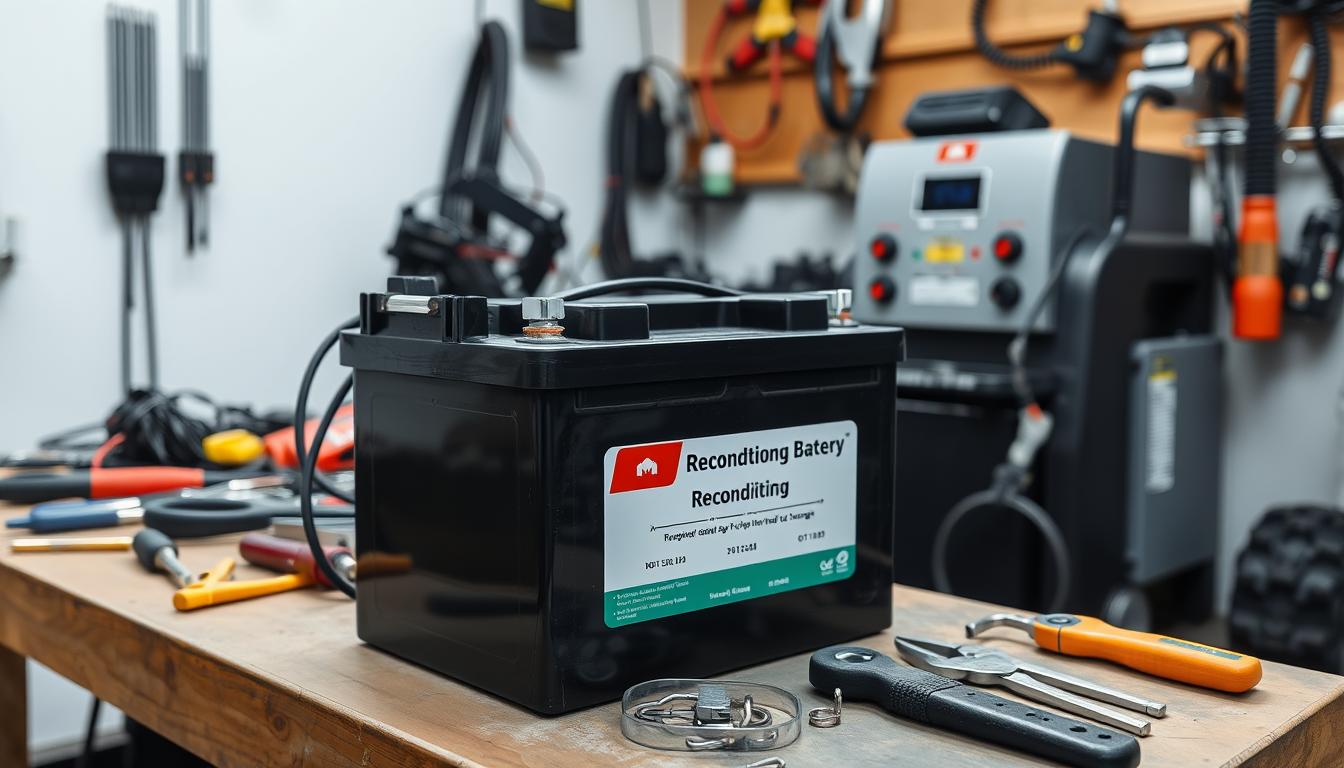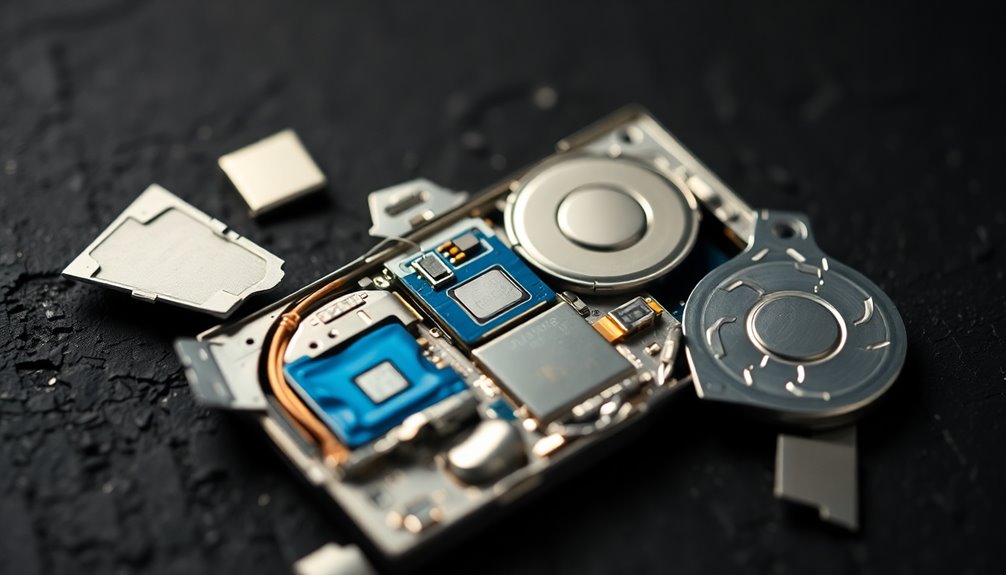Button batteries are tiny, round power sources you often find in devices like watches, remote controls, and hearing aids. Typically less than 25mm in diameter, they include popular types like lithium CR2032 and LR44, generating a stable 3V. These compact batteries excel in powering low-drain devices but can also handle high-drain applications, especially lithium variants. However, they come with serious safety risks, particularly for children, as ingestion can lead to severe injuries. Proper disposal is essential to prevent environmental damage. Stick around, and you'll uncover more about their safety, uses, and disposal practices!
Key Takeaways
- Button batteries are small, round batteries typically less than 25mm in diameter, commonly used in low-drain devices like watches and remote controls.
- They come in various types, such as lithium CR2032 and alkaline LR44, offering stable voltage for different applications.
- Button batteries can pose serious ingestion risks, especially to children, necessitating safe storage and disposal practices.
- Improper disposal of button batteries can lead to environmental pollution due to toxic substances like mercury and cadmium.
- Recycling initiatives and community education are crucial for promoting safe disposal and reducing health risks associated with button batteries.
Overview of Button Batteries

Button batteries, often overlooked due to their small size, play an essential role in powering everyday devices.
These small, round batteries typically measure less than 25mm in diameter and resemble coins. Commonly used types include lithium CR2032 and LR44, designed for electronics like watches and remote controls. They offer a voltage of 3V, making them perfect for low-drain applications.
However, because of their size and shape, button batteries pose significant ingestion risks, especially to children. If swallowed, they can lead to serious injury, as they can cause internal burns and other health hazards.
It's imperative to keep these batteries out of reach and guarantee safe disposal to prevent accidents. Always stay vigilant about the dangers they can pose.
Applications of Button Batteries

Button batteries are everywhere, powering everything from your wristwatch to remote controls.
They offer impressive performance, often lasting over a year, making them perfect for low-power devices.
Understanding their common uses and advantages can help you choose the right battery for your needs.
Common Uses and Devices
In countless everyday devices, button batteries play a crucial role by powering essential electronics. Their common uses span a variety of electronic devices, including watches, clocks, and remote controls.
You'll find lithium button batteries, like the CR2032, in high-drain devices such as digital thermometers and LED lights, thanks to their long-lasting power. Alkaline button batteries, while providing lower voltage, are often used in items requiring less energy.
Hearing aids rely heavily on button batteries due to their small size and reliability, making them ideal for portable electronics. However, be cautious—these tiny powerhouses pose significant risks if ingested, particularly by children.
Always store them securely to guarantee safety in your home.
Performance Specifications
Many small electronic devices rely on button batteries for their power needs, showcasing their versatility in various applications. The most common types include CR2032, LR44, and SR626, each offering different voltage and chemical compositions to suit specific devices.
Lithium button batteries are particularly effective, delivering a stable voltage of around 3V, making them perfect for high-drain applications like medical devices and digital watches. Alkaline variants, on the other hand, are ideal for lower-drain devices, providing reliable performance.
Known for their long service life, button batteries often last over a year in continuous use, and their low self-discharge rates mean they retain charge effectively, enhancing performance in standby modes.
Advantages of Button Batteries
Though you might not realize it, button batteries play an essential role in powering a wide range of everyday devices. Their compact size and high energy density make them perfect for low-drain electronics, ensuring long-lasting power. For instance, lithium button batteries, like the CR2032, are ideal for keyless entry systems, while zinc-air button batteries excel in hearing aids due to their efficiency.
| Device Type | Battery Type |
|---|---|
| Watches | Lithium Button |
| Remote Controls | Lithium Button |
| Hearing Aids | Zinc-Air |
| Digital Thermometers | Lithium Button |
| LED Lights | Lithium/Zinc-Air |
With low self-discharge rates, button batteries keep their charge, making them reliable even in devices used infrequently, ensuring safety around small children.
Safety Risks and Concerns

While button batteries are convenient for powering small devices, their ingestion poses serious safety risks, especially for young children. Over 3,500 cases of ingestion occur annually, with serious injuries reported more frequently in recent years.
These batteries can cause severe internal injuries, including burns and tissue damage, within just two hours if lodged in the esophagus.
- Approximately 12.6% of children under six face serious complications.
- Immediate medical attention is critical if ingestion is suspected.
- Avoid inducing vomiting, as it can worsen the situation.
The Consumer Product Safety Commission is urging manufacturers to strengthen safety standards and warnings.
Be vigilant, as button battery ingestion can lead to permanent damage or even fatal outcomes.
Emmett's Experience
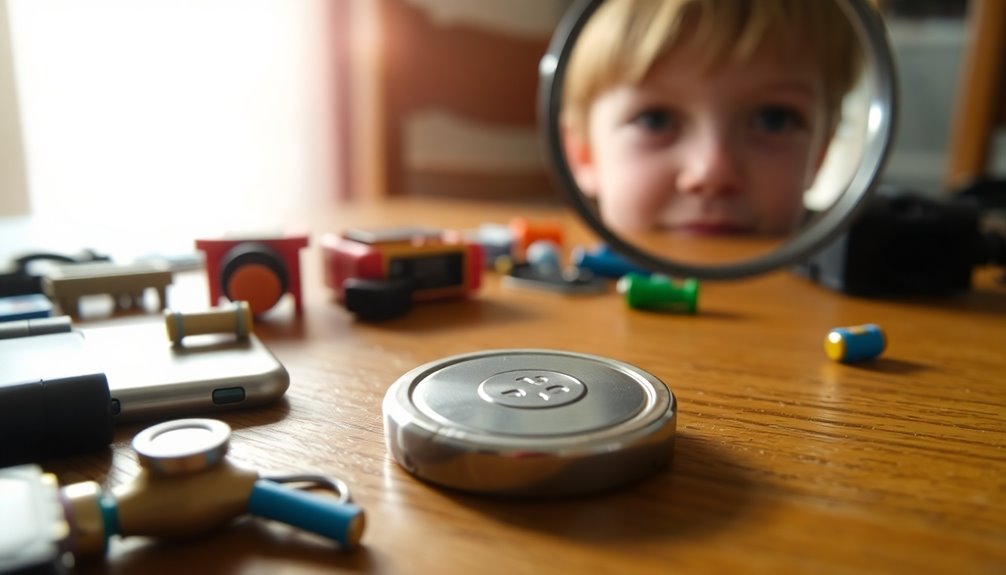
Button battery ingestion can lead to devastating consequences, as illustrated by Emmett's experience.
Swallowing button batteries can result in serious injuries, as Emmett discovered when a battery burned two holes in his esophagus and threatened his heart. His journey involved multiple surgeries to reconstruct his airway, showing just how critical immediate medical intervention is in these situations.
Emmett's recovery didn't just focus on healing; it also included regaining speech skills and eventually removing a tracheostomy.
The Rauch family shares Emmett's story to raise awareness about the dangers of button batteries and the life-threatening injuries they can cause. Their experience emphasizes the importance of preventive measures, urging you to inspect your home for devices involving these dangerous batteries to protect children.
Emergency Response Steps
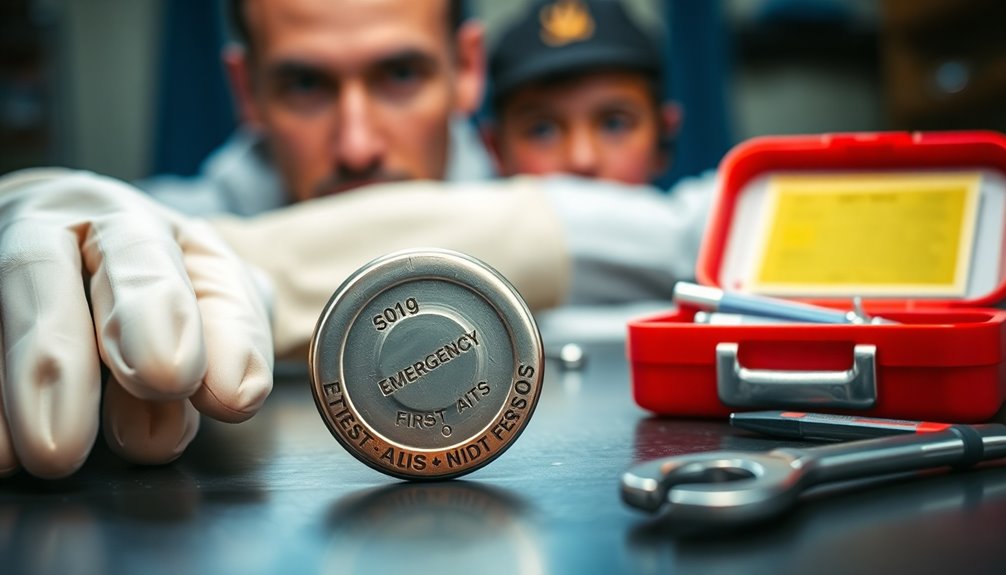
When you suspect a child has ingested a button battery, it's vital to act quickly and seek medical help right away.
Don't induce vomiting, as it can cause further harm. Here are key steps to follow:
- Administer 2 teaspoons of honey if the child is over 12 months, but avoid any other food or drink.
- An X-ray is important to check if the battery is lodged in the esophagus, which can lead to serious internal injuries.
- Monitor for symptoms of ingestion, including abdominal pain, difficulty swallowing, fever, and changes in behavior.
Always follow up with medical professionals to monitor for complications after initial treatment.
Time is essential in this emergency, so don't hesitate to act!
Statistics on Ingestion Incidents
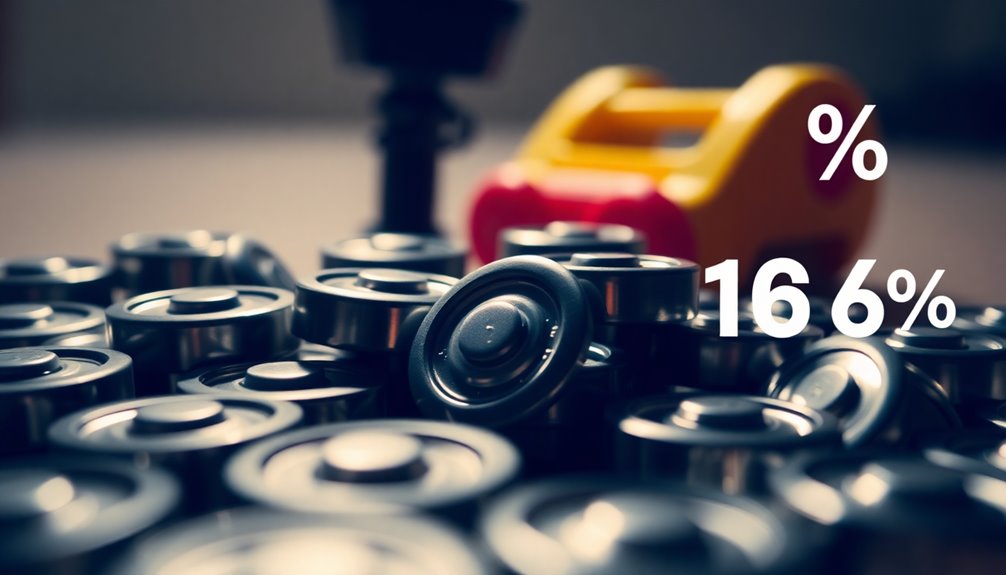
Every year, more than 3,500 cases of button battery ingestion occur in the U.S., mostly involving young children.
This alarming statistic underscores a growing trend of increasing severity, with emergency room visits for these incidents rising dramatically.
Understanding these numbers is essential to grasping the serious risks posed by button batteries.
Annual Ingestion Rates
Each year, over 3,500 cases of button battery ingestion are reported in the U.S., with more than 2,800 children requiring emergency room treatment. This alarming trend highlights a significant safety concern for parents and caregivers.
- On average, one child every three hours needs medical attention for ingestion.
- Serious injuries or fatalities have surged nine-fold in the past decade.
- Approximately 12.6% of children under six face serious complications from specific button batteries.
Between 2002 and 2021, there were 44 documented child deaths due to button battery ingestion, with the actual number likely higher.
It's essential to stay vigilant about the presence of these batteries and guarantee that they're stored safely to prevent tragic outcomes.
Increasing Severity Trends
As button battery ingestion incidents rise, the severity of these cases has become increasingly alarming. Over 3,500 cases are reported annually in the U.S., with more than 2,800 children treated in emergency rooms each year. That's one child every three hours!
The increase in serious injuries and fatalities from button battery ingestion has skyrocketed nine-fold in the last decade, making it a significant public health concern. Between 2002 and 2021, 44 child deaths were linked to these batteries, and the actual number is likely higher.
Additionally, a study from 1985 to 2009 revealed a sixfold rise in serious injuries. Awareness and prevention measures are urgent to combat this growing trend and protect our children from these dangerous hazards.
Proper Disposal Methods
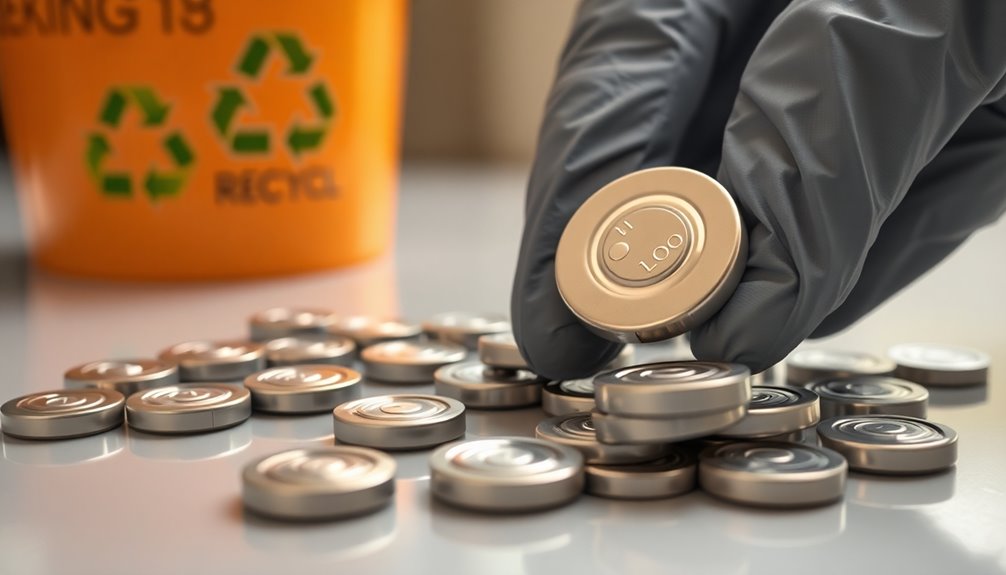
Proper disposal of button batteries is essential to protect both the environment and public health.
These tiny powerhouses contain toxic chemicals that can contribute to environmental pollution if not disposed of correctly.
To safely dispose of button batteries, follow these proper disposal methods:
- Use local hazardous waste disposal facilities to guarantee safe handling.
- Explore recycling options at designated centers that repurpose materials.
- Always separate button batteries from metals to avoid hazardous reactions.
Environmental Impact and Regulations
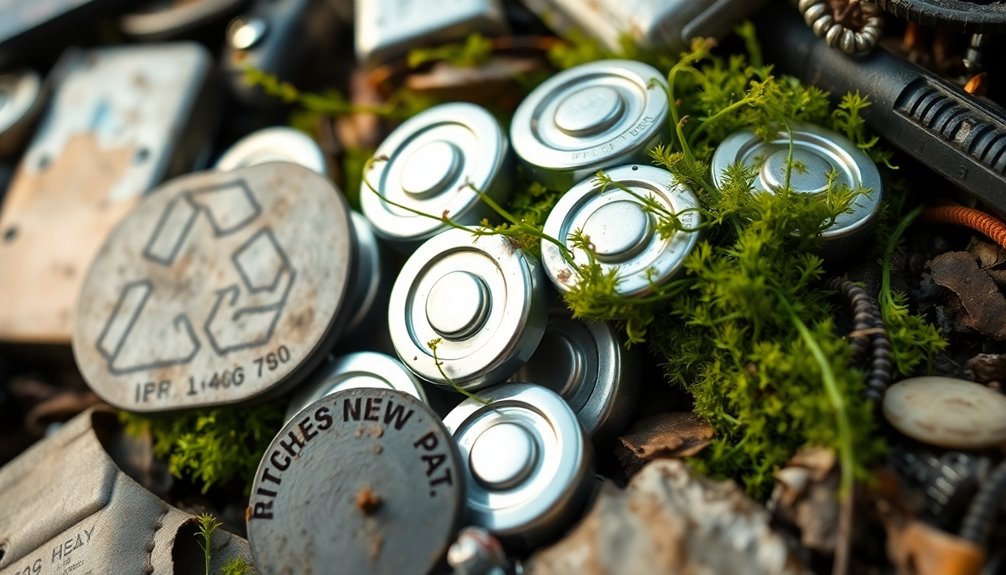
Although button batteries are small, their environmental impact is significant, especially when disposed of improperly. These batteries contain toxic substances like mercury and cadmium, which can harm both health and the environment.
That's why proper disposal is critical; you shouldn't throw them in standard waste. Instead, take them to designated hazardous waste disposal sites or recycling centers.
Regulations are evolving to enhance safety standards, including requiring child-resistant packaging and secure battery compartments, as seen in laws like Reese's Law.
Increased awareness of recycling initiatives for button batteries is essential to mitigate pollution and health risks. By understanding these regulations and their importance, you can help minimize the environmental impact of these tiny powerhouses.
Frequently Asked Questions
What Are the Tiny Batteries Called?
Those tiny batteries you're thinking of are called button batteries or coin cells.
They're compact and circular, usually ranging from 5 to 25mm in diameter.
You'll find them powering a variety of devices like watches, remote controls, and calculators.
Different types, such as CR2032 and LR44, provide varying voltages and performance levels.
Their small size and efficient power make them essential for many everyday electronic gadgets you rely on.
Why Are Button Batteries Illegal?
You know how some things come with a warning label, like a spicy chili pepper?
Button batteries aren't illegal, but they're under scrutiny due to safety concerns.
Particularly for kids, these tiny powerhouses pose significant risks if ingested.
Regulations are tightening up to guarantee safer packaging and design.
Instead of banning them outright, advocacy focuses on creating safer options, making certain you can enjoy technology without worrying about hidden dangers.
What Do the Codes on Watch Batteries Mean?
The codes on watch batteries help you identify their size, chemistry, and voltage.
For example, when you see a code like CR2032, it means you've got a lithium battery that's 20mm in diameter and 3.2mm high. The letters tell you the electrolyte type; "CR" stands for lithium manganese dioxide, while "SR" represents silver oxide.
Knowing these codes guarantees you choose the right battery for your device, preventing any malfunction or damage.
What Do Button Batteries Power?
Have you ever wondered what keeps your gadgets running smoothly?
Button batteries power a variety of small electronic devices, from watches and calculators to remote controls and keyless entry systems.
They're designed to provide long-lasting energy for low-drain applications, but some types can handle high-drain devices like medical equipment and hearing aids.
You'll also find them in everyday items like digital thermometers and LED lights, making them essential in your daily life.
Conclusion
In summary, button batteries are tiny powerhouses that pack a punch, but they also come with serious risks. It's essential to stay informed about their applications and safety concerns, especially if you have kids around. Just like a small spark can ignite a fire, a misplaced battery can lead to dangerous situations. By understanding how to handle and dispose of these batteries properly, you can help protect loved ones and the environment from their potential harm.




